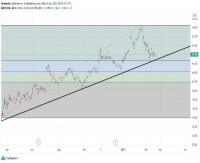|
Tales From the Algorithmic Front: Can Alpha Transform into Beta? An interesting comment came from a hedge fund professional recently. "When strong price trends occur, all trend followers correlate to one another," he said. "Essentially the manager "alpha" transformed into a replication of beta – the beta of a price trend. Any formula that identifies a trend and follows that trend is a beta play." It’s true that regardless of the trend following formula, during market environments of price persistence, trend followers typically benefit and would be expected to deliver positive returns along with the market environment. Conversely, during periods of "choppy" or directional less price trends managed futures trend followers may all experience degrees of difficulty. The conceptual argument was clear to me. During certain market environments the trend follower may experience "beta like performance" to the market environment of price persistence much in the same way purchasing an individual stock during periods of strong economic growth and overall stock market strength can reflect the beta of the stock market. In fact, in a recent Reuters article on Winton's David Harding, [link: http://www.reuters.com/article/2012/05/21/us-trading-blackbox-idUSBRE84K07320120521] the author notes that as strategies become known and use similar data performance might be similar. In other words, trend followers were becoming a beta, but it discounts the alpha located in the algorithm itself. Was crux of point was to question the "alpha," or individual manager skill, contained in a mathematical formula? Are trading algorithms “not individual manager skill?” (If I had a quarter for every time I heard this I might start a convertible bond arbitrage hedge fund, the real the definition of a crowded trade. This algorithm has no 'alpha' arguments are often made by fundamental hedge fund managers and discretionary CTAs, but it doesn’t get the point that the creator and manager of the formula is where the alpha resides. It's about how mathematical formulas are creatively developed, tested and monitored where the alpha in a formula comes. How has the manager created the algorithm to manage risk? What are the indicators used to trigger taking a loss? It is how a mathematical algorithm is designed to identify what volatility means, how market environments impact performance and how a formula operates. This is how a formula generates Alpha. Managed Futures Formula Growth All industries grow and mature. The innovative early trend following programs identified what some consider a basic market truism: trending markets can be identified by price momentum. Early on, this momentum was typically defined by two dimensional mathematical formulas. The most public of these formulas may be "Trader Vic," whose trend following model used common moving average cross-overs to determine the trend of a market. It is the topic of an industry discussion because the formula was licensed by S&P as a representative managed futures index. The formula operated based on prices of a commodity being either higher or lower than its seven month moving average. In trading algo lingo, a basic moving average cross pattern determined when to enter a trade and when to exit. [Link here to previous analysis of S&P trading methodology: http://bit.ly/p8SPeN] Trader Vic and many of the early trend followers were said to use these moving average crosses, and would all generate strong performance during periods of price persistence. (This is also discussed in this Reuters article [link: http://www.reuters.com/article/2012/05/21/us-trading-blackbox-idUSBRE84K07320120521] ] While this sounds like a basic formula, the details beneath the macro performance drivers are interesting. While the core algorithmic trigger was consistent – the moving average cross determined buy or sell execution – the method by which they managed their trades varied. For instance, CTAs varied their margin to equity exposure had very different performance – even if they used the same trade execution formula. Likewise, if two trend followers used the same formula to enter a position, how the position risk is managed differentiates the two. Some trend followers endure long drawdowns, while other trend followers use tighter downside risk control while sacrificing the opportunity to remain in a trending market. These trade modeling parameters built into each manager’s formula and they can be discerned and used to set investment expectations. Then a new movement, from a singular algorithmic formula to a dynamic "market sensing" formula might be typified by the S&P managed futures trend following index. S&P moved from the basic moving average cross model, which drove many of the trend following mutual funds, to a more dynamic trend following formula to determine market environment and then scale positions accordingly. The formula looks back to determine market environment and then scales positions accordingly. Unfortunately after launching the new concept, the market environment for trend following has been among the worst among recent memory. Trend following programs have adopted sophisticated formulas that go well past the simple moving average cross. For instance, certain systematic trend followers are known to have execution formulas to the point where algorithms sense market environment and then select the appropriate trade indicators. To view a previous white paper evaluating the S&P algorithmic development, click here: http://www.Go2ManagedFutures.com/mutualfund |
|
This article was published in Opalesque Futures Intelligence.
|





 RSS
RSS











